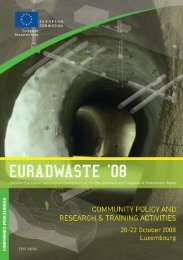EU industrial structure - EU Bookshop - Europa
EU industrial structure - EU Bookshop - Europa
EU industrial structure - EU Bookshop - Europa
You also want an ePaper? Increase the reach of your titles
YUMPU automatically turns print PDFs into web optimized ePapers that Google loves.
For countries as a whole, it should be noted that, in<br />
principle, specialization is not necessarily a good or<br />
bad thing per se. On one hand, specialization may<br />
reflect a natural focus on what the country does better<br />
relative to trade partners (comparative advantage), and<br />
hence a gain of overall productivity. On the other hand,<br />
diversification will always render a society more resilient<br />
to external shocks; a downturn in a specific sector can be<br />
compensated by other sectors still doing well and feeding<br />
public finances that eventually help cushion the negative<br />
impact of the shock (e.g., paying unemployment insurance).<br />
Nevertheless, diversification can also be seen as reflecting<br />
a society with a wider choice for its citizens; a high degree<br />
of diversification is very likely reflecting a strong and<br />
diverse human capital base that makes it possible to have<br />
from artists to engineers producing from haut couture<br />
to satellites. Given that by nature larger countries tend to<br />
be more diversified, countries below the line in figure II.6<br />
can be seen as reaping the benefits from having a more<br />
diversified economy than the average country given its size.<br />
In that reading, Belgium is a highly diversified country for<br />
its size whereas Italy, despite its large size, is less diversified<br />
and, in principle, more vulnerable to sectoral shocks or<br />
to competition from emerging economies due to high<br />
specialisation in low skill industries such as textiles and<br />
leather products.<br />
box II.2: Labour skills taxonomy<br />
Chapter II — Changes in <strong>EU</strong> Industrial <strong>structure</strong><br />
The taxonomy of labour skills is presented and discussed in Chapter II of O’Mahony and van Ark (2003),<br />
<strong>EU</strong> productivity and competitiveness — An industry perspective, European Commission. A measure of educational<br />
attainment is the metric that has been used to reflect skill intensity. The sectors from the NACE Rev1. classification<br />
were broken down in the following way:<br />
II.2 Skill and technology<br />
specialization<br />
The sectors analysed are classified according to the statistical<br />
nomenclature (NACE Rev. 2) presenting data on economic<br />
activities. It is sometimes useful to use other ways to classify<br />
sectors according to economic and technological criteria.<br />
Such classification can be used to illustrate similarities<br />
and differences between countries and sectors. Industry<br />
taxonomies are used for this purpose to group industries<br />
that have common characteristics. Once the taxonomies<br />
are applied to <strong>EU</strong> member states, it is possible to compare<br />
patterns across countries. The focus below is on two different<br />
taxonomies: one on skills and one on technology. It is not<br />
only the quantity of these inputs that matters for sectoral<br />
performance but also their qualities. As in the previous<br />
section, two different types of indicators are available:<br />
a breakdown by value added share and specialisation.<br />
ii21 changes in skills’ specialization<br />
The types of education and training that contribute to<br />
making a sector competitive can be very sector‑specific.<br />
Similarly, different levels of skills are needed across sectors.<br />
The measure of skill intensity, represented by the levels34 of education attainment that dominate in a sector, reflects<br />
this heterogeneity. The sectors in which people reached<br />
a similar level of educational attainment are classified<br />
according to different levels of skills. This led to four<br />
different categories, cf. Box II.2.<br />
low skill: A Agriculture, hunting and forestry, B Fishing, C Mining and quarrying, DA15 Manufacture of food<br />
products and beverages, DA16 Manufacture of tobacco products, DB Manufacture of textiles and textile products,<br />
DC Manufacture of leather and leather products, DH Manufacture of rubber and plastic products, DI Manufacture<br />
of other non‑metallic mineral products, DJ27 Manufacture of basic metals, DM34 Manufacture of motor vehicles,<br />
trailers and semi‑trailers, DN36 Manufacture of furniture; manufacturing n.e.c., DN37 Recycling, H Hotels and<br />
restaurants, O Other community, social, personal service activities.<br />
34 A common measure is the one provided by International<br />
Standard classification ISCED. The classification can be found on:<br />
http://www.uis.unesco.org/Pages/default.aspx<br />
45
















